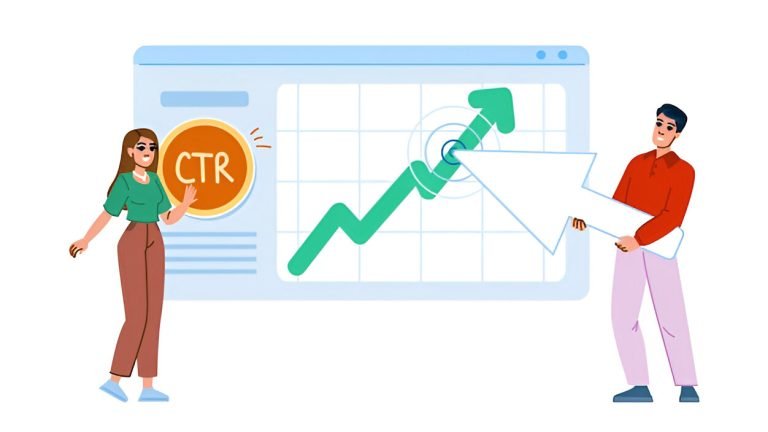
In the ever-evolving world of digital marketing, the rules of SEO are constantly being rewritten. Once upon a time, stuffing your content with keywords and building a mountain of backlinks was enough to climb the ranks on Google. Today, however, search engines and social media algorithms are much more sophisticated. One metric has emerged as a silent but powerful force in this new landscape: CTR, or Click-Through Rate. Therefore, for brands and businesses aiming to work with the Top SEO agency in Delhi, understanding and optimizing CTR is no longer optional—it’s essential.
What Is CTR?
CTR stands for Click-Through Rate, and it’s a metric that measures the percentage of users who click on a specific link out of the total number of users who view a page, email, or advertisement. In SEO, CTR typically refers to the ratio of users who click on your website link after seeing it in search engine results pages (SERPs).
Formula: CTR = (Clicks / Impressions) × 100
A higher CTR means that your listing was compelling enough to earn a click. Consequently, this not only drives more traffic but also sends a strong signal to search engines that your content is relevant and valuable.
Why CTR Matters More Than Ever
In 2025, Google and other platforms are placing a greater emphasis on user behavior. With the introduction of AI-driven experiences like Google’s Search Generative Experience (SGE), search engines are evaluating content not just by its structure or keyword density, but by how users interact with it.
If users consistently click on your link over others, Google interprets this as a sign that your page offers the best solution for that query. As a result, your page climbs higher in the rankings, even above pages with stronger domain authority or more backlinks.
The same logic applies to social media platforms. For instance, TikTok, Instagram Reels, and YouTube Shorts reward content that gets engagement fast. The first form of engagement? A click or tap.
Read more about Click-Through Rate
CTR's Impact on SEO Rankings
Search engines now consider behavioral metrics like:
- Dwell time (how long someone stays on your page)
- Bounce rate
- Pogo-sticking (when users quickly return to the search results after clicking)
- And most importantly, CTR
High CTR indicates that your title tag and meta description are compelling and relevant to the search query. This behavioral data is incredibly valuable to Google, which aims to provide users with the most useful content first.
When your CTR outperforms competitors, your content gets promoted more often—even if your backlink profile or domain age is weaker.
How to Improve Your CTR
Optimizing for CTR isn’t rocket science. However, it requires attention to detail and a deep understanding of your audience. Here are some proven strategies:
1. Write Irresistible Title Tags
Your title is the first thing users see. So, make it specific, emotional, and keyword-rich.
- Use numbers or brackets (e.g., “10 Tips to Improve CTR [Fast]”)
- Include power words (e.g., “Ultimate,” “Free,” “Proven”)
- Keep it under 60 characters
2. Craft Compelling Meta Descriptions
Meta descriptions should summarize the content while creating curiosity. Though not a ranking factor directly, they influence whether someone clicks your link.
- Use a call to action
- Highlight a benefit or solution
- Match user intent
3. Use Structured Data (Schema Markup)
Structured data can enhance your listings with rich snippets—ratings, FAQs, images, etc. Moreover, this additional info draws attention and improves CTR by making your listing more interactive.
4. Target Long-Tail Keywords
Long-tail queries are more specific and less competitive. Therefore, people searching these terms often have high intent, and your listing can stand out more easily.
5. A/B Test Headlines and Descriptions
Small tweaks can lead to major gains in CTR. Use tools like Google Search Console or even paid ads to test variations.
The Role of Thumbnails and Visuals
While visuals aren’t directly part of traditional SEO, they’re vital on platforms like YouTube, TikTok, and Instagram. For example, a scroll-stopping thumbnail or reel preview increases click-through dramatically. Even in search, having a strong featured image can impact clicks on blog posts.
CTR Beyond Google: Social Media and Ads
Social media algorithms also prioritize posts that get clicked. A tweet, Instagram Story, or TikTok that earns interaction quickly is pushed to more users. Furthermore, CTR impacts Quality Score in Google Ads, which directly affects your cost-per-click (CPC) and ad position.
In short: CTR is the universal signal of value across platforms.
CTR vs. Other Metrics
While it’s tempting to focus on rankings, impressions, or followers, CTR tells you how well your content actually attracts and converts attention. You could have 100,000 impressions and only 50 clicks—that’s a problem. On the other hand, a lower impression count with a higher CTR often leads to better ROI.
Tools to Monitor and Improve CTR
Here are some essential tools:
- Google Search Console: See CTR for individual keywords and pages
- Ahrefs / SEMrush: Identify low-CTR opportunities
- Yoast SEO / Rank Math: Optimize on-page elements easily
- Hotjar / Clarity: Analyze how users interact with your pages visually
Final Thoughts
As the digital marketing world grows more competitive, simply ranking on page one isn’t enough. You have to earn the click. CTR is the bridge between visibility and actual traffic—the missing link that determines whether your content wins or gets ignored.
Whether you’re writing blog posts, running ad campaigns, or designing social content, make CTR your priority metric. It not only boosts rankings and reach but also helps you understand what your audience truly finds valuable.
If you’re looking to dominate your digital strategy in 2025, working with the Top SEO agency in Delhi can give you the edge you need—especially when it comes to optimizing CTR for long-term performance.

